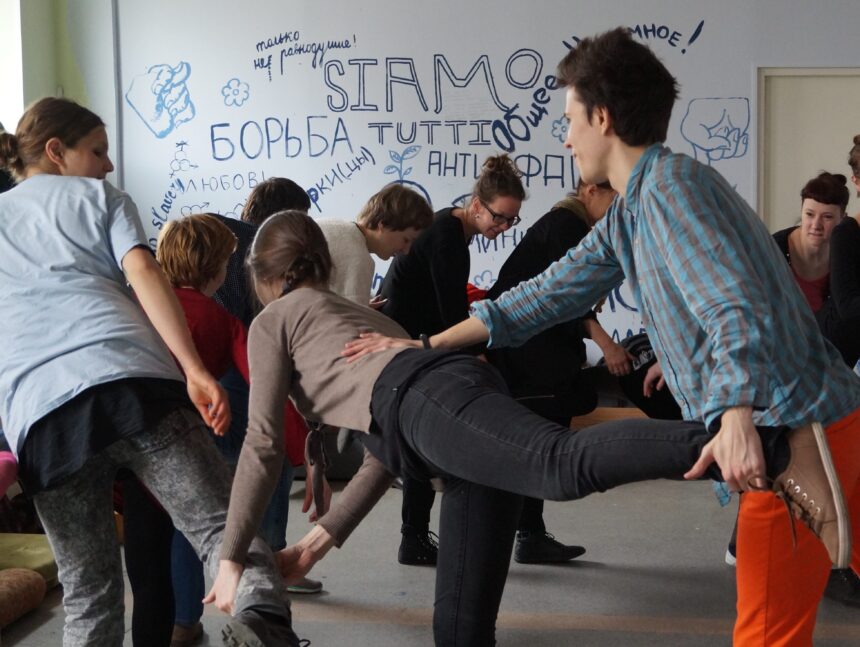A Discussion with the Residents of Rosa House of Culture (St. Petersburg)
Anastasia Vepreva: Today the idea of reimagining a “House of Culture” (HC) is a very relevant concept for twenty-first century post-Soviet Russian society.
Dmitry Vilensky: Yes, but let’s first clarify what the original Soviet Houses of Culture were, and how they were different from those of today. The common roots of this phenomenon lie in the goal of providing access to creative life for all social groups, which in the Soviet era meant organizing various forms of leisure activities during non-working hours. The main premise of Houses of Culture, therefore, was to involve people in cultural processes–from participating in theater, dance, cinema, photography, to drawing, or even aeromodelling [building model aircraft?]. At the same time, it was a very ideological space, serving all kinds of political purposes, including as a meeting place for the Communist party’s members and professional unions, as well as a site for staging formal political events and celebrations. Clearly, you can’t do a lot with this heritage, because the fabric of Soviet social life that legitimated the HC’s existence has completely disintegrated.
Anastasia Vepreva: Yes, today, the average Russian enjoys visiting enormous department stores that offer a lot of options to enhance one’s creativity including offering educational classes, interactive games, and discussion groups, as well as of course shopping. These are ostensibly the contemporary version of the HC. But the idea of the Soviet HC has been turned inside out and no longer operates on a socialist basis. Instead it openly embraces neoliberal ideology and consumerist culture. It’s logical therefore that against this background we find young, successful cosmopolitan Russians in search of new forms for creative self-realization, and the Rosa House of Culture (RHC) is one response to that need. On the other hand, in your comments Dmitry, you appear to be arguing that any new model of a House of Culture can only exist within a counter-public sphere, an enclosed space in which common ground must first be generated before a wider public is invited to join in. Still, with this in mind, to what extent is this proposed counter-public sphere a seriously limiting factor that prevents people from accessing alternative models of the RHC from one side? And from other side, does it allow the participants of the House of Culture to remain in a safe enclosed space for as long as possible and not to go out to the general public?
Roman Osminkin: The very idea of Rosa House of Culture as a place of collective cultural production, in a country where all forms of collectivity have been totally devalued and dismantled, poses a peculiar challenge to the state-corporate reality which we have now in Russia. Meanwhile, the ideals of the early Soviet Houses of Culture were a part of the USSR’s much wider life-building program, which included the creation of the new human being [the Soviet “New Man”?] for whom art and culture would not just reflect life, but play an organizing role, along with of course Taylorist models of industrial production (which was responsible for organizing the collective laboring body) and the communalization of private life (in communes). Practically speaking, the entire life of the new proletariat was managed by the combined discipline imposed by carefully calibrated forms of time-measured labor, education and leisure. Surprisingly, this socialist “being of the expose,” [exposed being or self?] whose every move, be it labor or leisure, was on display within a visible regime, has reemerged in capitalist Russia today. In fact, it is in demand by today’s creative clusters [industries?], which have communalized processes of work and leisure, and production and consumption, in order to produce a regime of “collectivity-in-separation.” As Boris Groys puts it
People put the information about themselves on the Internet, including Facebook or Youtube, precisely because they want to be observed, controlled and be robbed of their privacy. …But there is also an even deeper anxiety to be exposed to no eye at all, to remain completely unseen. [1]
Today, this “collectivity-in-separation” is going through its own crisis as squats and self-organized cultural spaces try to preserve their autonomy under the pressure of re-development and gentrification machines. They are sometimes normalized as creative spaces (though rarely as legalized social centers). I agree with Dmitry–in part–for example when calls Rosa House of Culture a “counter-public” space, a space for a free assembly of the outcasts of modern Russia. However, this counter-public existence is always at risk of ending up as total self-marginalization. The prefix “counter” signifies not only anti-publicness, but the aspiration to form your own “public” existence on a basis, different from hegemonic, state-approved and commercial principles.

Dmitry Vilensky: As Nancy Fraser has correctly observed, spaces like new Houses of Culture or semi-autonomous Social Centers “function as spaces of withdrawal and regroupment” and “as bases and training grounds for agitational activities directed toward wider publics” by various marginalized groups. This space should promote the dissemination of alternative (counter) forms of knowledge, which develop these groups and provoke them toward reciprocal cooperation, drawing them toward the common cause and creating new alignments of solidarity.
Also we can think about it as experimentation in “open autonomy”. This means the faith in certain principles of socialism (free access to creativity groups, ideals of collectivism, anti-commercial approaches, inclusiveness, etc…) and an aspiration to expand that sector of our participating body which is ready to share these ideals, and which are completely repressed in our society. Of course it risks marginalization and we cannot ignore the fact that we face more and more shrinking space for our activities and survival. Nevertheless, I can’t see any other options but intensification of work and creation of protocols of openness. We, the collective Chto Delat, intend the work of the HC to be akin to a House with perpetually open doors, a place where the public comes to participate in a certain environment–to read books, drink tea, train in particular sections–and not leave the House, after they finish, the same as when they arrived. But it seems we have been mistaken about the last objective. Today, all (though especially, young people) live on a different, very intense schedule, far from the abundance of free time that was available during socialism, making the open and relaxed experience of HC difficult to achieve.

Roman Osminkin: We live in the era of edutainment. People go to the museum and galleries not only to see exhibitions, but also to get knowledge (critical knowing included). So why should they go to Rosa House of Culture, and also return there again? It is not clear. But back in the 1920s a member of LEF group (“ЛЕФ“: Left Front of the Arts), Sergey Tretyakov posed a foundational question. In his statement “Club-combinat” or “Club-assemblage” the avant-garde pioneer wrote about the difficulty of bringing the worker into these socialist clubs and retaining him/her there, because cultivating a “new habit of being in a club is not playing around, but a real deal.” In attempting to redefine this “real deal,” the question involves why workers should come and return to the club and this must be a major part of the conversation regarding the necessity of these spaces. We can begin with the fact that instead of the figure of worker we have today a population with a much more complicated and dispersed identity whose time-management is not split between work and leisure, not subjected to the speed and direction of an assembly line, but diffused across many fields of activity. Instead of top-down organizational rules imposed by authorities, budget demands, and so forth, what has taken shape in the post-Soviet era is the self-organization of workers with their own personal protocols of participation and an almost complete absence of financing from outside sources (government organizations). It is a potentially very productive, but also, a very vulnerable position.
Jozhi Stolet: In relation to the public sphere, it’s necessary to get out from being confined within the dichotomy of “openess for all” (like 24/7 supermarkets) and self-enclosed sub-cultures. I think the solution lies in creating forms of collectivity through some kind of “kinship,” and also meta-protocol is important here, but it doesn’t seem to me that the expansion of the public sphere should involve accumulating various identities (LGBTQ+, political activists, feminists, etc.). Instead I see this creation taking shape through sharing common practices that are different from neoliberal rules of existence. For example, this is how it works with the Belarusian art project/cultural platform “Work Hard, Play Hard!” In the mission statement that functions like a protocol, you can only enter the project through engagement in practice and research, not through the concept of “identity.” [http://workhardplay.pw/en/2018/#]

Anastasia Vepreva: Indeed, the Rosa House of Culture, in a sense, carries on a liberatory-educational function: it stands against the hegemony of commercial and consumerist approaches to culture, aspires to stands by its values and demonstrate possibilities for their realization. Today, the following creative initiatives are based there: the theatrical studio of Sofia Akimova, a few performative and dance groups including Alexey Achyo, Marina Shamova and Natalia Merkulova, and the School of Engaged Art run by Chto Delat. Besides these occupants there are seminars such as “Libertarian robot technologies,” Jozhi’s Stolet’s seminar on philosophy and feminist reading group, as well as several foreign language classes. All of these projects follow the logic of the Soviet “Kruzhok,” a state supported literary and artistic circle involving assorted activities or sections whose participants come and go during designated hours. Doesn’t the HC, in this case, turn into the open space for the use of some friends and acquaintances who do not necessarily share a socialist ideological framework? Doesn’t the RHC, in this case, turn into just a space with free rent for people who do not necessarily share a common experience or socialist ideological framework? How can different activities sections produce a common ground, especially if they don’t even intersect with one another?
Roman Osminkin: This is one of the most important questions. If we consider Rosa House of Culture as an emerging system, which is more than just a sum of its activity sections, then we would know that desired commonality can’t emerge from a simple, even friendly, cohabitation of different and equal initiatives under the same roof. We should not try to define a common ground for all activity sections artificially, it should instead come out naturally from our more than three-years-experience of commonality and cohabitation in the HC, as well as from the practice of producing a theory. One of the initial steps could be a practice of regular intersectional meetings, during which the participants of different sections would share their findings, experiences, and perhaps, produce some new forms of collaboration.
Jozhi Stolet: The deficit of public spaces in St. Petersburg creates a lot of pressure on HC as artists and educators and other programmers compete with each other for time slots. This situation produces a huge stress for coordinators and organizers, especially when the collective’s social potential isn’t fully realized. People can invent their own activity in the premises of the House of Culture, but they can’t invent the HC itself. I think that a de-hermeticization of these semi-closed communities, in parallel with the collective creation of new formats and practices, could help distribute this administrative load more equitably.

Roman Osminkin: Deleuze’s and Guattari’s nomadology theory makes a point about solidarity of individuals that grows proportionally to the growth of its diversity. Diversity is constructed through a constant process of cultural exchange and individuals’ relationships with each other. But the reality we live in is, unfortunately, far much tougher than this, and our nomadic diversity is predetermined (or pre-formatted) by big institutions and corporations. We are allowed to play in a children’s sandbox of identities, but as soon as we go beyond these limits, all of our “selves” crumble within the grinding wheels of “capitalist realism” (Mark Fisher), which reduces everything to a marketplace assortment of affects and pleasures. Therefore, the Rosa House of Culture while continuing to promote the idea of diversity, at the same time, should carry out an understanding of culture as a common deed as it aspires to become not simply a counter-public space, but a true ‘common space’–a space where people practice different types of commonality (depressive, without closeness, artistic, political, ecological, civil, gender, etc.), already, or still impossible in today’s Russian society.
Anastasia Vepreva is an artist, curator, and art critic from Saint Petersburg, Russia. She was born in Arkhangelsk in 1989. She writes about systems of oppression, artificial intelligence, Memory Studies and the concept of death and has published in Moscow Art Magazine, Art Leaks Gazette, Colta.ru and Aroundart.org
Roman Sergeevich Osminkin is a Saint Petersburg based poet, art-theorist, performer and video-artist. He is the author of poetry and short prose books including Comrade-Thing (Kraft, 2010), Comrade-Word (Kraft, 2012), Texts with External Objectives (NLO, 2015) and Not A Word About Politics! (Cicada Press, New York, 2016). He was a member of the Laboratory of Poetic Actionism (interventions into public space).
Jozhi Stolet (Saint Petersburg), studied Philosophy at SPb State University and is now engaged in modern philosophy and cyberfeminism theory. She runs the program in “new philosophical grammar and methodology” at DK Rosa, which involves research into intimate interfaces at the Centre of Intimate Communication Connections.
Dmitry Vilensky is an artist and educator, as well as a founding member of the Chto Delat collective and curator of the School of Engaged Art. He is also a co-founder of Rosa’s House of Culture.
Notes
1. “Interview with Boris Groys,” Theory Culture & Society, June 5, 2011: https://www.theoryculturesociety.org/interview-with-boris-groys/










